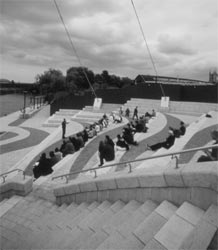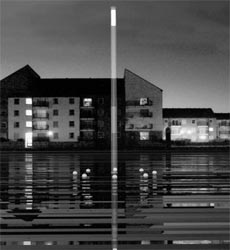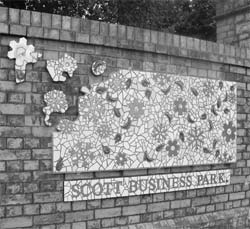PASW Regional Newsletters: Autumn 2003
Focus On Current Projects & Issues
Locational Identities: Dialogue - Temporary Public Art Symposium
Arnolfini and Harbourside, Bristol 5 July 2003
'To love a city is to know the fates of its outstanding citizens, to know not only its famous churches but also its little corners, its parks, its hidden secrets.' Ivan Klima.
In July 2003 dialogue presented thirteen, new, contemporary art works on Bristol Dockside. The programme was commissioned by Independent Artists Network with artists from Hanover, Oporto and the UK invited to devise a series of temporary works connected by location on Bristol harbourside.
The Symposium, which provided a platform for artists and curators to discuss the resonances of site-specific, temporary interventions in the public realm, began with the above quote, delivered by historian Michael Manson, as an anchor to his exploration of Bristol docks, past and present. Adam Sutherland followed with a summary of his curatorial approach to Grizedale Arts, which has involved introducing public engagement works by contemporary artists into an area renowned for traditional landscape art.

Artist Otiose describes his work 'Popular Territory' on the steps at Temple Quay.
Photo: Stuary Bunce
The juxtaposition of these two speakers set the context for the day - part of which was spent on a ferry tour to view the works commissioned for «dialogue'. This floating discourse courtesy of Jim McNeil, poet and historian and Bristol Ferry Boat Co., gave delegates an intimate waterways view of visual and audio dialogues that included:
- a silent film sequence of a visually impaired accordion player in Oporto by Gabriela Vaz-Pinheiro;
- multi-lingual, conversing cranes by Natalie Deseke;
- hidden glimpses of performance artist Eve Dent.
Outside the formality of the auditorium the audience engaged in stimulating discussion, both with each other and the artists, as they walked and talked between the works.
The debate which continued back at the Arnolfini was chaired by Maggie Bolt, Director of Public Art South West, and teased out respective views on context and identity and the distinctions of off-site works, closing on a plenary discussion with the speakers and artist-participants from UK, Germany and Portugal.
Artist and curator Louise Short organised the Symposium on behalf of ALIAS (Artist Led Initiative Advisory Service, Arts Council South West). The Independent Artists Network team hope this Symposium will be a beginning for future debates and discussions arising from art practice in pubic spaces.
Carolyn Black, Project Manager, [email protected]
Louise Short, Symposium Organiser, [email protected]
New Public Art Officer for Somerset
A new post of Public Art Officer for Somerset has been established with support from PASW. John Brady, from Liverpool, was appointed and took up post in April. He works out of the County Council's Arts Unit at Bridgwater. "The existence of various sketchy ideas of what public art may or may not be is hardly surprising considering the County has not had a specialist officer in place before. However there is significant public art activity going on throughout the County. It ranges from the very ambitious to modest and small-scale. Much of it is well conceived and well managed, but some is poorly managed and dependant on the whim or enthusiasm of small groups of individuals working in isolation. There are no commonly agreed definitions, standards, codes of practice or an existing infrastructure. The provision of such is my priority.

Breaking the Surface, Bridgwater Dock. Artist: Michael Pinsky
Starting at the outer limits of contemporary practise would not be constructive. Going back to basics to develop dialogue with colleagues, communities and developers is key. I have begun with a robust definition of public art intended as a common starting point. The definition of public art* as a singular specialism helps differentiate it from that plurality of singing, dancing, acting, painting, writing, etc., collectively termed as the 'arts'. Uniquely, but not exclusively, public art involves digging and building, with engineers, planners, architects and artists working together. My colleagues and I have a public art policy in draft and would welcome comment on it. Please contact me at the e.mail address below for further information".
* Public art may be primarlily defined as 'the integration of material artworks within developments of the built and antural environment.'
John Brady [email protected]
Public Art at a Former Hospital site in Plymouth
Plymouth City Council is working closely with a local CEDT, Wolseley Trust, residents and other partners to facilitate a community arts project at a former hospital site in Plymouth. Most of the former hospital buildings have been demolished and the site has been transformed into the 'Scott Business Park', a community facility combining a Healthy Living Centre and Business Units using European Objective 2, Regional Development Agency, New Opportunities Funding, SRB, Wolseley Trust and Plymouth City Council funds. Public art has been involved in this development thanks to council planning that specifically supports this type of activity.
The site sits in North Prospect, a largely disadvantaged neighbourhood within Plymouth that is undergoing a time of change through a neighbourhood renewal programme which seeks to tackle various social exclusion and deprivation issues. The former hospital site is still remembered in the neighbourhood as an isolation hospital but is also widely known as being named in honour of Robert Falcon Scott, the intrepid Antarctic explorer who came from the local area.

Mural by Emma Spring.
Photo: PLymouth City Council
A group of artists have been employed by a separate project team to work on three commissions that loosely relate to the theme of 'Scott and the Antarctic':
• Improvements to the Boundary Walls and Gateways - (Noah Taylor and Emma Spring ) - to incorporate a combination of Mural and Brickwork along the boundary wall and some metal entrance gating and lighting work.
• A Central Feature and Sculpture Trail - (Steve Geliot) - creation of a Central Feature using free standing large pieces of carved wood along with smaller sized sculptures that form the «thread of life' sculpture trail.
• A Community Portrait - (Gez Taylor) - Traditional yet contemporary portrait of a much admired community activist who recently passed away.
Inspiration for the main commissions has been drawn from a variety of subjects including, the range of shapes and profiles that ice, snow, light and shadows form and the tiny life forms that live beneath the Antarctic rocks.
Completion date is expected to be around the end of August.
Wolseley Trust, 01752 203670
Plymouth City Council, 01752 305540
City Centre Redevelopment Projects - Exeter and Bristol
Land Securities Group PLC, one of the largest property developers in the UK, are currently redeveloping significant parts of the city centre shopping areas in Bristol and Exeter.
In Bristol, the Bristol Alliance - a partnership between Land Securities, Hammerson and Morley Fund Management - are extending the Broadmead area and in Exeter, the existing Princesshay area will be regenerated with new shops, offices and residential accommodation. In both developments, new road and pedestrian infrastructure is being created, along with new public spaces, and work to improve existing open spaces.
Land Securities have engaged public art consultants Sam Wilkinson and Hazel Colquhoun to create strategies for involving artists at both sites. The first artists are already in place. In Bristol, Nayan Kulkarni has been working with Chapman Taylor architects to create a new 'outdoor roof' and pedestrian bridges for a significant new public square. In Exeter, Patricia MacKinnon-Day has been working alongside landscape architects Livingstone Eyre on the redevelopment of the historic city centre Almshouses and the public square in which they are sited.
Further commissions will include artists working on car parks with Wilkinson Eyre and on newly created open spaces with Panter Hudspith and lighting designers Spiers and Major. There will also be programmes of temporary commissions taking place over the construction periods of each development, and projects which include process and participative work to engage with local residents and also those who shop and work in the city centres. Calls for interest from artists for future commissions are going out through Artist Newsletter and regional media outlets.
Hazel Colquhoun [email protected]
Swindon - Public Art Update
Swindon Borough Council's Artscape is now part of the Arts Council South West region. Artscape (formerly Public Art Unit) is a small team of three arts officers that programmes and manages a range of professional arts for the Council including festivals, concerts, exhibitions and visual arts projects. The manager of Artscape is responsible for the commissioning programme through the Council's public art policy and also leads on the strategic development of this provision.
The Council adopted Swindon 's public art policy in 1988 and since that date there has 52 permanent and temporary commissions. Since 2000 a primary objective for Artscape's manager has been advocacy. Swindon's planning department had seen several changes and with almost completely new staff together with enormous pressures to turn planning applications round rapidly, public art and the ability to draw down funds through the Council's Percent for Art scheme was not able to be prioritised.
Public Art is now firmly on the planning department agenda and together with the Council's new draft Local Plan backed with supplementary planning guidance and codes of practice on Percent for Art, Swindon has the potential to enter a new phase in its public art programme.
However substantial work still needs to be done in terms of advocacy. Swindon has a change of political leadership and many Councillors are new to local government, this has brought its challenges. The time has come for Swindon to review its Public Art Policy, to take stock of the past 15 years and make strategic decisions for the future enabling the Council and its partners to re-commit to the benefits of public art practice.
In the meantime there are 15 projects in progress and, for the first time, a public art fund resourced through developers' contributions in order to engage and involve artists in the redevelopment of Swindon 's town centre. For an update on recent projects visit www.swindonartscape.co.uk . And see Celebrating Swindon below.
Celebrating Swindon
An Artists residency at ASDA Wal-Mart Supercentre
Swindon 2001 - 2003
In November 2001 international artists team Simon Grennan and Christopher Sperandio were appointed as resident artists at the new ASDA Wal-Mart Supercentre in Haydon Wick, Swindon. The artists' brief was to research and develop a major temporary artwork reflecting the relationship between the store, its customers and its new, and growing local community.

Shifting Gear Bus by Grennan and Sperandio.
Photo: James Newell
Grennan & Sperandio started their residency the day the store opened to the public on 26 November 2001. The artists visited Swindon regularly over the first year, meeting a wide range of community groups - from Technics keyboard club to ecology groups, beekeepers and filmmakers - and talking with residents, not only in the store, but also from all around the town and from all walks of life. Their aim was to try and understand what gives Swindon its unique character. Their research culminated in a year long project - Celebrating Swindon - which reflects the people they met, the stories they were told, and a whole range of activities taking place in Swindon, particularly in the Haydon area.
Celebrating Swindon consists of two parts: Shifting Gear - a fully colour painted bus and billboard campaign, presenting cartoon portraits of Swindon residents; and Visioning ASDA ¾ a project with pupils from Hreod Parkway School, Haydon, to create animated screen savers for the new North Swindon Library.
Celebrating Swindon is a Grennan & Sperandio project, commissioned by ASDA Wal-Mart and Swindon Borough council's Artscape and developed and managed by Artpoint.
Artscape Manager: [email protected] or 01793 466517.
Beaford Arts Field Development Project
Beaford Arts was founded in 1966 as the first rural arts organisation in the UK. Since that time it has developed a strong local and national reputation for innovative work engaging communities with a range of different types of arts practice. Having recently completed a comprehensive period of organisational review and development, the Council of Management made the decision to optimise one of the organisation's major assets; a field owned by the organisation. Beaford Arts believes that the arts should be central to the development of the field and that this project offers major scope for an integrated, whole-community approach to development and regeneration, involving consultation and partnerships at a local and regional level, but with the potential for a significant national impact, advocating locally, regionally and nationally for the involvement of the arts in further rural development schemes.

Field development project discussion event, August 2003.
Photo: Lisa Harty
Recognising the opportunity the development afforded the organisation and the village of Beaford, Beaford Arts has appointed the Artist, Philip Power and Architect, Jason Cornish to work on the consultation and concept design stage of this innovative and exciting project where the arts will be at the centre of the entire development process and where the role of the arts in rural regeneration will be exemplified. The project is underway with a series of community events planned for the summer period with this stage of the project due for completion in late Autumn.
Lisa Harty, Project Manager, [email protected]
